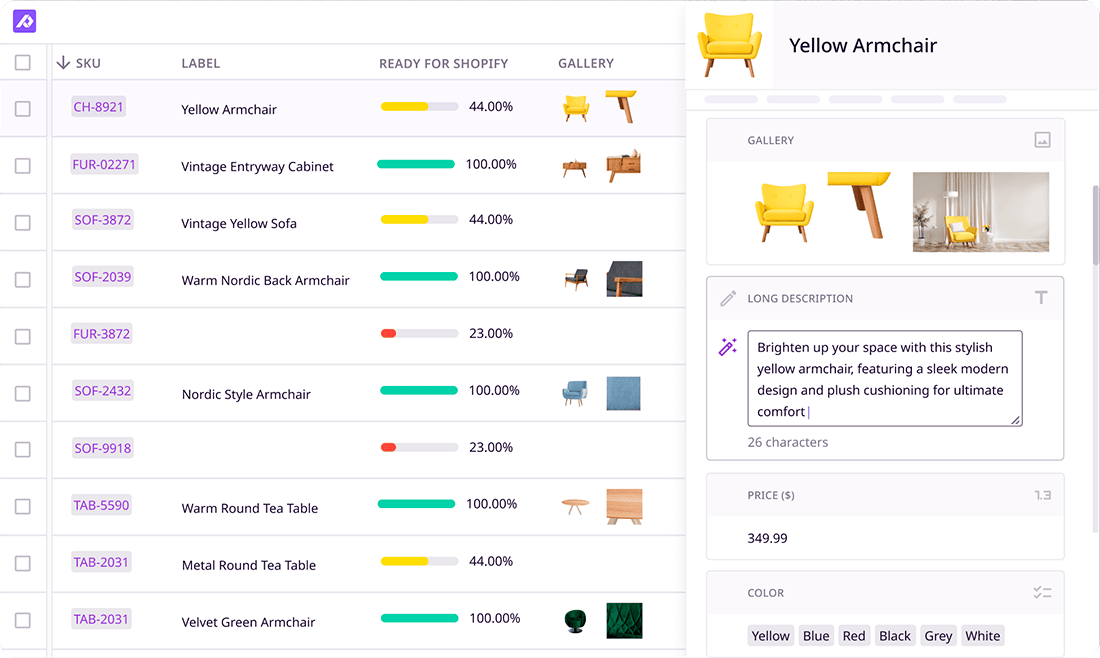
Keep the good stuff coming
Subscribe to our blog newsletter and get monthly content that helps you manage product data smarter.
No spam. Just real value.
If you're a retailer struggling with managing product information, then you should know that you're not alone. Managing large amounts of data can be a daunting task, which is why loads of retailers and resellers get frustrated by it—it's not just you!
At Plytix, we're super familiar with your situation and all the data-related trials and tribulations that come with it. We designed our product information software with retailers in mind in order to help them (and you) manage product data efficiently in one place—so your frustrations are our frustrations.
Larry Oxley, our Head of Sales, says that one of the biggest problems retailers face is managing all the data they get from suppliers.
“Before they can do anything, they have to format and edit it all for their webstore, which, if you think about it, can take a lot of time. So, they come to us with the hopes of reducing the time and amount of effort that goes into doing this task.”
— Larry Oxley, Head of Sales at Plytix
If you can relate to this struggle, then you’ve come to the right place. In this article, we go into detail about how a PIM tool works, the different types of data it can handle, and the benefits it provides for retailers.
What is PIM software for retail?
PIM software has four primary functions: to centralize, optimize, enrich, and distribute your data. What does that actually mean? Well, put simply, it means you can get all of your data and assets into one place, make sure they're complete and accurate, add in any extra content or details needed, and then easily send them out to your different sales channels in a variety of ways.
What kinds of retail data can a PIM tool handle?
There are plenty of different types of retail data that you can manage with PIM software—here are some of the most important ones.
- Product descriptions: Detailed and unique descriptions of products, including size, features, and specifications.
- Pricing information: Data regarding the cost of products, pricing strategies, promotional pricing, and discounts.
- SKU data: Stock Keeping Unit information, which includes unique identifiers for each product to track inventory and sales.
- Product images and videos: High-quality media files associated with each product for use in online catalogs, marketing materials, and product displays.
- Supplier information: Details about the suppliers including contact information, terms of supply, and lead times.
- Category management: Information on how products are categorized and organized, which helps in navigating the product catalog more efficiently.
- Multilingual content: Product information in multiple languages to cater to diverse geographical markets, improving customer experience and expanding market reach.
How does a PIM system help retail companies?
There are multiple reasons to switch to a PIM system, especially if you’re still using spreadsheets or another non-specialized type of software. So let’s dive in!
PIM gives you a centralized product catalog
All retailers have to deal with loads of incoming product information from suppliers, but that information is nowhere near ready to be sent out to customers, webstores, or marketplaces. This is because the data can be:
- Inconsistent in style and/or format
- Incomplete or missing vital points
- Inaccurate or out-of-date
Having to deal with product data like this is enough to make a grown product manager cry because it’s just so tedious, time-consuming, and inefficient. It also has the consequence of increasing your time to market, making it much less likely that you can get new products in front of customers before your competitors.
Using product information management software means you don’t have to deal with that, as you have a single source of truth to store all incoming information. What's more, you can make sure product data is consistent and accurate across all sales channels in a matter of minutes—with just a few clicks.
 Let’s take Telco Accessories, for example. After implementing PIM software, they gained a much more controlled approach to how they handle product information, and are now able to manage their data more efficiently overall. On top of that, they can now store double the amount of data after investing in Plytix compared to the time before they adopted PIM.
Let’s take Telco Accessories, for example. After implementing PIM software, they gained a much more controlled approach to how they handle product information, and are now able to manage their data more efficiently overall. On top of that, they can now store double the amount of data after investing in Plytix compared to the time before they adopted PIM.
You don’t have to just take our word for it about what our PIM did for them—you can get their story directly right here.
PIM improves product data quality
Product data quality in commerce is a big deal. Inaccurate pricing, sizes, or materials are a breeding ground for product returns, or even losing customers completely due to the damage done to the customer experience.
Online shoppers cannot see the product in real-time, so they depend on your product data to get a better understanding of the products they wish to buy. Retailers with physical stores need accurate data too—you need to give your customers everything possible to make them feel confident about their purchases, regardless of where they choose to shop. According to this article, about 65% of all ecommerce returns are caused by the retailer, with at least 22% caused by inaccurate product information.

With Plytix, you can make sure you have brand consistency with accurate information on all sales channels. Our platform has features such as in-cell editing, bulk editing, data validation, and product completion tracking to make sure that your product data is standardized, validated, and enriched. That way, you can have error-free information that provides a great customer experience.
“Plytix is a game changer because of the easily searchable, filterable and centralized point for our product data; that can be edited in bulk and missing or incomplete data easily identified.”
— Diane B, small business owner
PIM allows you to update your product data efficiently
Product information management isn’t a one-off project. It’s an ongoing thing because your data needs to be constantly updated and enriched so that it matches the requirements of your sales channels. Without a PIM tool, keeping up with this can become dreadful (another potential reason that you’re here).

PIM gives you a competitive edge in the market
Retail can be a cut-throat environment because there are similar brands around every corner. You need to be efficient in launching new products and bringing in sales. With a product information system, you can launch new products a lot quicker. That’s because PIM helps you create product information, validate, and publish in less time than you would without it. And, to back this up, a lot of PIM adopters have seen that they send products to market 2X faster than they did before PIM.

Not only can you send products to market faster in your country, but also when you consider branching out to other regions. This is because a PIM tool also stores localized content. You can streamline all your processes for your multiple stores in less time and make sure you continue to one-up your competitors as you consistently meet customer demands.
For more tips on how to localize your product information for various markets, read this article here.
PIM allows for better multichannel selling
Multichannel selling (selling products on multiple sales channels at once) is no joke. While there are many sales benefits that come with selling on multiple platforms, if you aren’t managing your product information better, it won’t take you far.
If you don’t properly send accurate product data to your sales channels, you could find yourself getting your product listing removed. But this doesn’t have to be your reality when you have a PIM solution. That’s because it allows you to create channel-specific product content quicker with fewer chances for inaccuracies. This allows you to focus on sending the products to your online marketplaces, website, and physical stores in less time. With Plytix, you can do quick exports in various formats.
 Toner Buzz, a retailer who adopted Plytix, saw how beneficial having a PIM is. The company has three websites they manage. With Plytix, they no longer have to:
Toner Buzz, a retailer who adopted Plytix, saw how beneficial having a PIM is. The company has three websites they manage. With Plytix, they no longer have to:
-
Manage from their ecommerce platform directly (which slowed down productivity).
-
Update products one by one as they’ve been able to edit in bulk and send updated content to multiple sites at the same time.
This has allowed them to manage their multiple sales channels easily. In the end, this has also helped them reach more customers, improve their customer experience, and increase sales.
PIM helps you improve sales and customer experience
Keeping online shoppers happy doesn’t need to be hard. All you need to do is make sure that you have all the information they need to decide on what to buy. When you have a product information tool, you don’t need to worry about having inaccurate information that will cause problems in your customer’s shopping journey.
You can guarantee that they have all the details they need to complete a purchase. That helps you improve customer experience, reduce product returns, and bring in more sales.
 Musco Food experienced this firsthand when they got a PIM. With PIM software, their sales reps were able to improve their customer experience because they could handle client requests faster and give them accurate information at all times. Now they have a good relationship with their clients and sales coming in as they have accurate information on hand every day.
Musco Food experienced this firsthand when they got a PIM. With PIM software, their sales reps were able to improve their customer experience because they could handle client requests faster and give them accurate information at all times. Now they have a good relationship with their clients and sales coming in as they have accurate information on hand every day.
Make the switch to PIM today
Product information management for retail is a game-changer. It helps you deal with one of the biggest issues you are facing: how to manage product information efficiently.
Businesses that have taken the plunge into PIM continue to see the benefits, and you can too. Trust us, we’ve seen how many companies have benefited from our SaaS PIM solution, and we want the same for you!
For more information on what PIM options are in the market, download our free PIM buyer's guide. And if you’re interested in learning more about Plytix, book a demo with us—we promise it will be worth your while.
Frequently Asked Questions
A PIM, or Product Information Management system, in retail is a software tool designed to help retailers manage all their product data in one centralized location. It allows for the centralization, optimization, enrichment, and distribution of product data across multiple sales channels. This includes handling complex data like product descriptions, pricing, SKU information, images, videos, and multilingual content to ensure accurate and consistent information is shared everywhere.
Companies need a PIM to manage product information efficiently, as this data can be particularly complex and voluminous. A PIM system reduces the time and effort required to maintain product data, improves data quality by ensuring information is accurate and consistent, and helps speed up the time to market. This is crucial in a competitive retail environment where efficient data management directly impacts sales and customer satisfaction.
No, a PIM is not an ERP (Enterprise Resource Planning) system. While both PIM and ERP systems manage important business data, their focuses are different. ERP systems are broader and manage a wide range of business processes including inventory, accounting, human resources, and more. PIM specifically focuses on managing product information and is used to enhance how product data is handled across marketing and sales channels.
PIM systems are used by a variety of stakeholders within a retail company, including product managers, marketing teams, sales teams, and ecommerce managers. These tools are crucial for businesses that manage extensive product ranges and need to distribute consistent product information across multiple sales channels, both online and offline. PIM systems are especially beneficial for companies looking to improve their multichannel selling strategies and enhance overall customer experience.

What if your product data actually worked for you?
We’ll show you how Plytix helps you stop fixing data—and start using it.
Related posts
Keep the good stuff coming
Subscribe to our blog newsletter and get monthly content that helps you manage product data smarter.
No spam. Just real value.






Think others should see this?
Go ahead and share it.